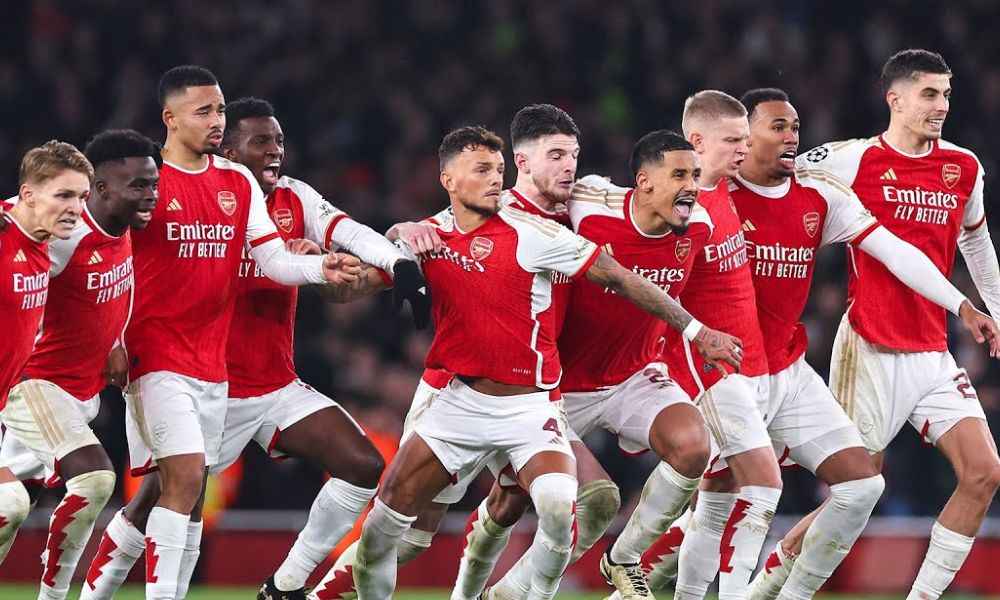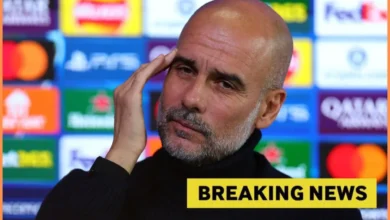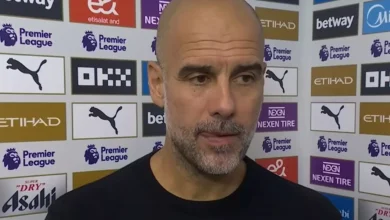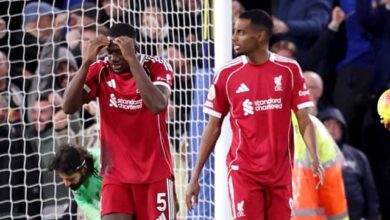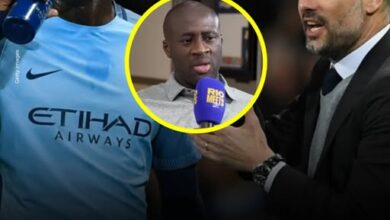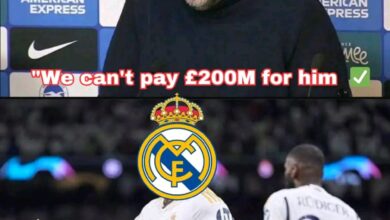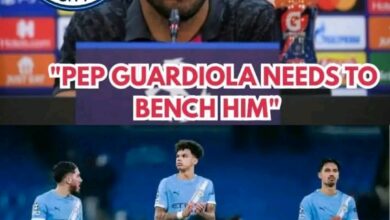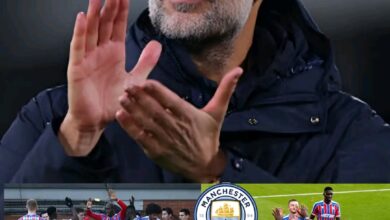The Hammer in the Neck: Pep Guardiola’s Fascinating Comparison Between Bernardo Silva and Lionel Messi Introduction: An Unexpected Analogy from Football’s Greatest Tactician
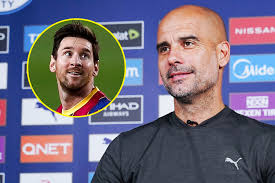
In the world of football management, few figures command as much attention and respect as Pep Guardiola. The Manchester City manager, renowned for his tactical innovations and philosophical approach to the beautiful game, has never been one to shy away from colorful descriptions of his players. However, his recent comments following Manchester City’s Champions League victory over Villarreal have sparked widespread fascination and amusement across the football community. After witnessing midfielder Bernardo Silva power home a header despite his relatively diminutive stature, Guardiola drew an intriguing parallel between the Portuguese international and none other than Lionel Messi, claiming both possess what he described as a “hammer in their necks.”
This peculiar anatomical observation, while initially puzzling to many, reveals deeper truths about the qualities that separate exceptional footballers from their peers. It also provides insight into Guardiola’s unique perspective on the game and his ability to identify special attributes in players that might escape the notice of others. The comparison is particularly significant given Guardiola’s intimate knowledge of Messi’s capabilities, having managed the Argentine superstar during their legendary spell together at Barcelona, where they rewrote football history and established standards of excellence that continue to influence the sport today.
The Match Context: Manchester City’s Return to Form
The setting for Guardiola’s memorable comments was Manchester City’s impressive 2-0 victory over Villarreal in the Champions League on a Tuesday night that saw the English champions demonstrate why they remain one of Europe’s most formidable forces. The match, played at Villarreal’s stadium, represented a significant challenge for City, as the Spanish side has earned a reputation as one of La Liga’s most resilient and tactically astute teams, particularly dangerous on their home turf.
Manchester City’s performance was characterized by control, confidence, and clinical finishing—qualities that have defined their success under Guardiola’s stewardship. The opening goal came from the inevitable Erling Haaland, the Norwegian striker whose goal-scoring prowess has become almost routine for City supporters. However, it was the second goal that captured everyone’s imagination and prompted Guardiola’s unique observation.
Bernardo Silva, standing at just 5’8″ (173 cm), rose in the center of the penalty area to power a header past the Villarreal goalkeeper, doubling City’s advantage and effectively securing three crucial points in the Champions League league phase. For a player of Silva’s stature to generate such force and accuracy with a header is genuinely remarkable, and it was this display of unlikely aerial prowess that sparked Guardiola’s comparison to Messi.
The victory was particularly significant for Manchester City as it elevated them into the Champions League top eight, three matches into the competition’s league phase. This achievement came despite the continued absence of Rodri, the Spanish midfielder whose importance to City’s system cannot be overstated. The team’s ability to maintain their high standards without such a crucial component speaks to the depth of quality within the squad and Guardiola’s tactical flexibility.
Decoding Guardiola’s “Hammer” Metaphor
When Guardiola stated, “I’m pleased that Erling scored again; and pleased that Bernardo made an incredible header again. It’s a little bit like [Lionel] Messi, it’s a hammer. They have a hammer in their neck, they are so good. They are small but they are so good with their head contact,” he was articulating something that coaches and analysts have long observed but struggled to explain adequately.
The “hammer” metaphor appears to reference the explosive power and precision that both Silva and Messi can generate when making contact with the ball using their heads, despite their lack of height advantage over taller opponents. In football, aerial ability is traditionally associated with physically imposing players who can use their height and strength to dominate in the air. Players like Cristiano Ronaldo, Virgil van Dijk, or Sergio Ramos spring to mind when discussing heading prowess.
However, Guardiola’s observation highlights a different type of aerial threat—one that relies not on height or reach, but on technique, timing, neck strength, and the ability to generate surprising force from compact body positions. The “hammer” suggests a concentrated burst of power, a sudden striking force that contradicts expectations based on physical stature alone.
This quality is particularly valuable in modern football, where defenders might underestimate the aerial threat posed by smaller, technically-gifted players. When a 5’8″ player attacks the ball with the same conviction and power as someone six inches taller, it creates an element of surprise that can be devastatingly effective.
The Messi Connection: A Manager’s Intimate Knowledge
Guardiola’s comparison gains significant weight from his unique relationship with Lionel Messi. During their time together at Barcelona from 2008 to 2012, Guardiola and Messi formed one of the most successful partnerships in football history. Under Guardiola’s management, Messi evolved from a supremely talented winger into arguably the greatest player the sport has ever seen, winning multiple Ballon d’Or awards and leading Barcelona to an unprecedented sextuple in 2009.
This intimate working relationship means that when Guardiola makes observations about Messi’s abilities, he speaks from a position of unparalleled authority. He has watched Messi train daily, studied his movements, analyzed his decision-making, and witnessed firsthand the physical and technical attributes that enable the Argentine to perform feats that seem impossible for a player of his size.
Messi, standing at 5’7″ (170 cm), has never been known primarily as a header of the ball. His legendary status stems from his dribbling, vision, passing, and finishing with his left foot. However, throughout his career, Messi has scored numerous important headed goals, often in crucial moments. The 2009 Champions League final header against Manchester United, when Barcelona won 2-0 in Rome, stands as perhaps the most iconic example. Messi’s ability to generate power and accuracy with his head despite his height has always been one of the subtle weapons in his vast arsenal.
By comparing Silva to Messi in this specific aspect, Guardiola is not suggesting that Silva possesses Messi’s overall genius—that would be an unreasonable claim about any player. Instead, he is identifying a particular shared characteristic: an unexplained capacity to excel in an area where physical limitations should theoretically be prohibitive.
Bernardo Silva: The Complete Modern Midfielder
To understand the significance of Guardiola’s praise, one must appreciate Bernardo Silva’s evolution as a player and his importance to Manchester City’s system. The Portuguese international joined City from AS Monaco in 2017 and has since established himself as one of the most technically accomplished and tactically intelligent midfielders in world football.
Silva’s game is characterized by exceptional close control, creative passing, tireless work rate, and tactical versatility. He can operate effectively in multiple positions across midfield and the attacking line, adapting his role to suit the team’s needs in any given match. Under Guardiola’s guidance, Silva has developed into a player who combines technical excellence with tactical discipline—a combination that epitomizes the Spanish manager’s footballing philosophy.
The fact that Silva has now been appointed club captain speaks volumes about his standing within the Manchester City hierarchy. At 31 years old, he represents experience, consistency, and leadership qualities that Guardiola values immensely. His ability to perform in crucial matches, maintain high standards over a full season, and adapt to different tactical requirements makes him indispensable to City’s ambitions.
The headed goal against Villarreal showcased yet another dimension to Silva’s game. While he may never be considered a traditional aerial threat, his willingness to attack crosses and his technique when making contact with the ball demonstrate the complete nature of his skill set. This versatility and unpredictability make him even more valuable in Guardiola’s intricate tactical schemes.
Social Media’s Reaction: When Football Meets Comedy
The football community’s response to Guardiola’s comments highlights the intersection between serious tactical analysis and the lighter, more entertaining aspects of the sport’s culture. Social media platforms exploded with reactions ranging from genuine appreciation of Guardiola’s insight to humorous observations about his unique way of describing players.
Comments like “Pep just be inventing anatomy at this point” and “Only Pep could make heading sound like an art form” reflect the affectionate amusement that Guardiola’s more philosophical musings often inspire. There’s a recognition that while his descriptions might sometimes seem eccentric, they often contain profound observations about the game that become clearer upon reflection.
One particularly entertaining comment—”Bro’s built like a USB stick but headers like prime Ronaldo”—perfectly captures the incongruity between Silva’s slight frame and the power he generated with his header. The reference to Ronaldo, widely considered one of the greatest headers of the ball in football history despite not being exceptionally tall, adds another layer to the discussion about what makes certain players effective in the air.
The observation that Guardiola was “always finding a point to involve Messi” reflects the ongoing fascination with the relationship between manager and former player. Guardiola’s frequent references to Messi, even years after their Barcelona partnership ended, demonstrate the lasting impression the Argentine made on him and the standard of excellence that Messi represents in Guardiola’s mind.
The Science Behind the “Hammer”: Biomechanics and Technique
While Guardiola’s description might seem whimsical, there is legitimate biomechanical science that could explain why certain shorter players excel at heading despite their height disadvantage. The “hammer” effect he describes likely relates to several physical and technical factors.
First, neck strength and core stability play crucial roles in generating power when heading the ball. Shorter players who have developed exceptional strength in these areas can create surprising force when making contact. The neck muscles act as a spring-loaded mechanism, storing energy that is then explosively released upon impact with the ball.
Second, timing and positioning are often more important than height when it comes to effective heading. Taller players may rely on their natural advantage to win aerial duels, but shorter players must perfect their timing, reading of flight paths, and positioning to compete. This necessity often leads to superior technique that translates into more accurate and powerful headers.
Third, the lower center of gravity that shorter players possess can actually be advantageous in certain heading situations. When attacking balls in crowded penalty areas, the ability to maintain balance and stability while generating upward force can be more valuable than simply being tall.
Additionally, the explosive speed and acceleration that many shorter, technically-gifted players possess allows them to attack the ball with greater velocity than taller, less mobile opponents. When Silva rises to meet a cross, he may be covering less vertical distance than a taller player, but he does so with such speed and conviction that the resulting power rivals or exceeds what larger players can generate.
Manchester City’s Broader Context: Finding Rhythm Without Rodri
The Villarreal victory must be understood within the broader context of Manchester City’s season and the challenges they have faced. The absence of Rodri, their Spanish defensive midfielder who won the 2024 Ballon d’Or, represents a significant blow to the team’s structure and balance. Rodri’s ability to control tempo, provide defensive stability, and link defense with attack makes him irreplaceable in the truest sense of the word.
However, City’s performance against Villarreal demonstrated their capacity to maintain high standards despite this crucial absence. Guardiola’s comments about the team “coming back to what we were in the past” suggest that he recognizes his squad is rediscovering the qualities that made them dominant in previous seasons. The confidence, control, and clinical finishing displayed against Villarreal are encouraging signs for City supporters.
The team’s impressive record of seven victories and two draws in their first nine matches across all competitions indicates that they remain serious contenders for every trophy they compete for. The depth of quality within the squad, exemplified by players like Silva stepping up in different ways, provides Guardiola with the resources to adapt and overcome adversity.
Rico Lewis’s comments after the match revealed the mentality within the squad. His observation that “when you’re playing with confidence there’s nothing to stop you but yourself” reflects the self-belief that has returned to the team. The young defender also highlighted the collective trust that binds the squad together—a crucial ingredient in any successful team.
The Haaland Factor: A Different Kind of Aerial Threat
While Guardiola’s comments focused on Silva’s unexpected heading ability, the match also featured yet another goal from Erling Haaland, whose aerial prowess represents the more traditional model of heading excellence. The Norwegian striker combines exceptional height (6’4″ or 194 cm), remarkable athleticism, and precise timing to dominate defenders in the air.
Rico Lewis’s description of Haaland as “impossible to defend” captures the striker’s impact on Manchester City’s attacking dynamics. His presence draws defenders’ attention, creating space for teammates like Silva to exploit. When teams commit resources to marking Haaland, it opens opportunities for City’s other attackers. Conversely, when defenses fail to track Haaland properly, his finishing ability punishes them mercilessly.
The contrast between Haaland’s and Silva’s headed goals in the same match illustrates the diverse attacking threats that Guardiola has assembled. While Haaland represents raw power and physical dominance, Silva’s goal demonstrated technical excellence and unexpected capability. Together, they create a multi-dimensional attack that is extremely difficult for opponents to neutralize.
Looking Ahead: Silva’s Legacy and City’s Ambitions
At 31 years old and in his potential final season at Manchester City, Bernardo Silva’s headed goal against Villarreal adds another chapter to his already impressive legacy at the club. Speculation about his possible departure next summer adds poignancy to moments like these, reminding supporters to appreciate his contributions while he remains in Manchester.
Silva’s appointment as club captain recognizes not only his technical abilities but also his professionalism, consistency, and understanding of what Manchester City represents. His journey from Monaco to becoming one of Guardiola’s most trusted players embodies the club’s modern era of success.
The upcoming fixture against Aston Villa presents an immediate test of City’s credentials. Villa’s impressive form, with five consecutive victories across all competitions, means they will arrive at the Etihad Stadium full of confidence. Guardiola’s men will need to build on the Villarreal performance and demonstrate that their recent improvement is sustainable rather than temporary.
For Manchester City’s broader ambitions—defending their Premier League title, progressing deep into the Champions League, and competing for domestic cups—players like Silva will be crucial. His ability to influence matches in multiple ways, including unexpected headed goals, provides Guardiola with the tactical flexibility that has defined City’s success.
Conclusion: The Artistry in Unexpected Excellence
Pep Guardiola’s comparison between Bernardo Silva and Lionel Messi, focusing on their shared “hammer in their necks,” transcends simple post-match commentary to reveal something deeper about football excellence. It reminds us that greatness in sport often manifests in unexpected ways and that the most complete players are those who overcome physical limitations through technical mastery, mental strength, and relentless dedication.
The comparison also reflects Guardiola’s unique perspective as a manager who thinks deeply about the game and articulates his observations in ways that challenge conventional thinking. Whether describing Silva’s neck muscles as containing a hammer or developing revolutionary tactical systems, Guardiola approaches football as both science and art.
As Manchester City continues their pursuit of glory across multiple competitions, moments like Silva’s header against Villarreal serve as reminders that success in football requires contributions from all areas. While star strikers like Haaland will always capture headlines, the unexpected excellence demonstrated by players like Silva—the “hammer” in the neck that allows a small midfielder to power home headers—often proves equally decisive.
Guardiola’s comments, initially puzzling but ultimately profound, have given us a new way to appreciate the subtle qualities that separate good players from exceptional ones. In the ongoing narrative of Manchester City’s season and Bernardo Silva’s career, this particular goal and the manager’s memorable reaction to it will occupy a special place, exemplifying the unexpected moments of brilliance that make football endlessly fascinating.
